|
I Don't Eat Cactuses Anymore
After the usual exploration of the lush local vegetation a harsh blow awaited us. Our favorite Guyaba trees were entirely devoid of fruit - ripened, dropped off, eaten. And the next ones will be ready in half a year. Rats! It was again up to fragrant oranges and the dark red fruits of Tunera Cactuses to save the day.
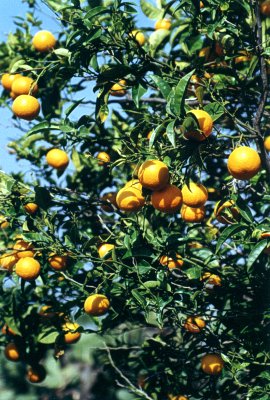
A pleasant surprise on the other hand was the, for us, as yet unknown just ripening fruit called, Nispero. In appearance it resembles small pears and the juicy, sweet flavor is something between our yellow plums, red plums and peaches. So you choose. Another surprise awaits inside. Dark pits in amounts of 2 to 5 with a surface so slick that shot from between your fingers you can hit a pedestrian 20 meters away. Nostalgically I remembered the pit of the Czech Cherry tree which I couldn't hit a friend's eye with at 10 meters! Of course not long after having eaten our fill of the yellow berries and competed for the most pits found, I went ask of the locals, just to be certain, what the name of this fruit of such exquisite taste was, and most importantly, was it edible? The answer only confirmed the fact that on the island of La Palma it is possible to eat just about anything that grows out of the ground without worry.
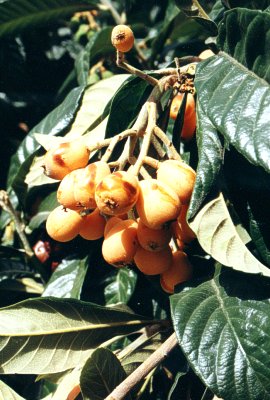
Only the ever-present green bananas following our past bad experience, being the exception. The indigenous inhabitants of old times themselves only ate them in cases of extreme need, and boiled at that.
The banana plant is an interesting one if studied closer. It is not a tree as may at first seem, but a grass. The "blade" of this grass is, however, 20 cm thick on the average, reaches heights of over 3m and in the midst of a banana plantation one feels as if in a forest. At the top of the adult plant only one bloom grows during its entire life span. Beneath it then begin to grow rosettes of small bananas in the shape of a bunch. The blossom with its growing weight begins to bend the thick stalk in its upper part towards the earth and the whole bunch then ripens upside down. No plantation owner allows the bunch to ripen completely. It would be impossible to ship. Bunches of bananas are packed green and then ripen artificially in the countries of destination. Good thing our friend Winston prepared some bananas for us several weeks ahead of time. When we arrived at our rented house in the village of Fuencaliente (Los Canarios), they had begun to ripen nicely in the kitchen.
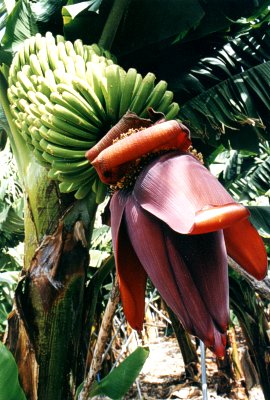
In the local kitchen however, the great chef turned out to be Michal. His invitation for spicy chicken steak with rice that never sticks I accepted at first with much embarrassment and worry, but the next night I didn't even bother smelling the chicken risotto since it was obvious that it would be just as great as yesterday's steak, if not better. From that time on I suspect that Michal had been a ship's cook in a past life.
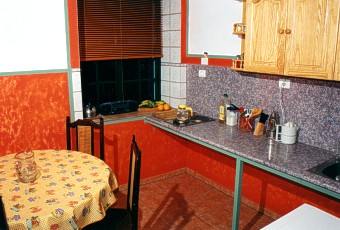
In the local worker's bar, the Parilla Grill, in the village of Fuencaliente (Los Canarios) they no longer greeted us with the official "Buenas Noches" , but with the familiar "Hola". We like going there because we're not talking about an ordinary tourist restaurant, but a typical pub for local residents with excellent food and drink for normal prices. For example, delicious fish with potatoes comes to about 170 Czech Crowns in conversion, and it's a true Canary Islands Man portion.
|
This time we had it in mind to try something different than on our previous expedition, and it worked. After finding out that they could fry up for us the hitherto unknown fish called Chicharro and pour us local wine called Matyas, which we hadn't yet tasted, some of us immediately began to salivate all the way to our shoes. The fin in combination with the wine tasted delicious and we didn't forget to order the spicy Mojo Verde silantro sauce and the Papas Arrugadas potatoes to go along with them. These potatoes are eaten along with their skin and are boiled in a precise amount of seawater, which, once boiled away, is just the right amount to finish the potatoes. The sea salt coats the skin adding a piquant flavor. The sea salt obviously increases one's thirst and after four bottles of Matyas we staggered heavily through the darkened village to our cottage, which fortunately is only a stone's throw from the pub. It's also fortunate that, being from Moravia, I'm used to consuming quality wine in larger quantities. I didn't fall asleep until four minutes after coming in, three of which were spent taking my shoes off.
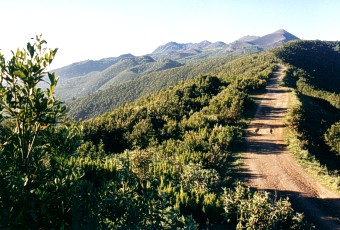
Reventón a Roque de los Muchachos
This time around we were able to add two new runways to the Terrains for flying section, which fall into the category of runways above 1000 meters. One of them we weren't able to find on our last expedition to La Palma, and the other one we were worried about local regulations. Both of these reasons are now in the past.
The Reventon runway is to be found on the main crest of the island, at an altitude of 1360 meters above sea level. Take off is east over the city of Santa Cruz and on the way you fly over the Mirador de la Concepcion. Perpendicular from the forest trail a short steep ramp sticks out into open space, and which is slowly being overgrown with mountain grass. For a paraglider, however, the forest path is too narrow.
All runways with an altitude of over 1,000 meters above sea level are problematic in general on the Canary Islands (refer to the article on the expedition to Tenerife). The reason is the relatively high local humidity of the air and the resulting low altitude of the cloud base. During the morning evolution of convection, all higher runways find themselves either directly within the forming cloud cover, or above it. For this reason they are useful only for morning flights down to the beach on the shore, because in the early morning hours the weak thermics don't yet allow keeping yourself in the air.
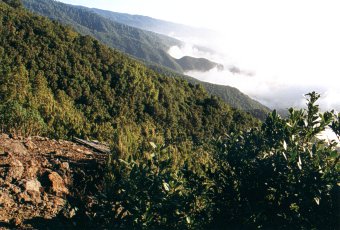
The highest mountain on the island of La Palma is named Roque de Los Muchachos, is 2,426 meters above sea level and is located in the national park, Parque Nacional de la Caldera de Taburiente. Understandably, it is prohibited to take off from the beautiful runway barely 50m from the peak, which was confirmed for us even by the flyers from the local club in Puerto Naos. The residents of the Canary Islands, and Spaniards in general, have an odd mentality. They understand all laws and regulations as a necessary evil and completely disregard them. During the carnival days for example, we saw unbelievable things on the streets and no one thought twice about them. Further, before 9a.m. virtually nothing and no one works and taking off from the peak of the highest mountain of the island is understandably necessary before nine, before the premature evolution of cloud layer covers the majestic, sharp morning sunlit crests around which it is necessary to fly.
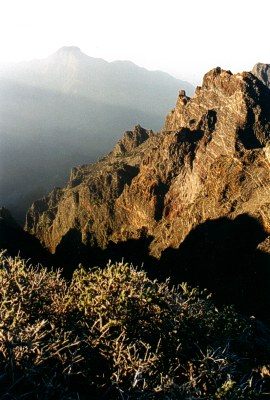
So one beautiful day we got up at 5 in the morning while it was still dark, daringly set out to an altitude of 2,400m and at 8:15 were standing on the runway. Crystal clear air, good visibility, but the wind element was definitely against flying. The cold-as-North-pole and a relatively strong West wind is blowing, which, during a flight around sharp rocky crests equals suicide. Total lack of wind is best here. Nothing left to do but humbly bow to the elements and drive down 1,800m lower to Mirador El Time. The call of the highest mountain on the island called Roque de Los Muchachos is too strong not to get up and try again the next time we visit the Island of La Palma.
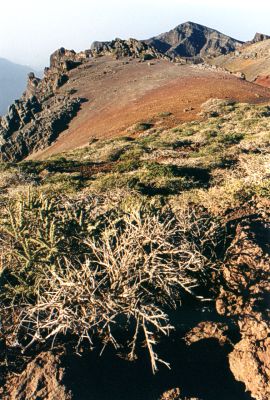
|







